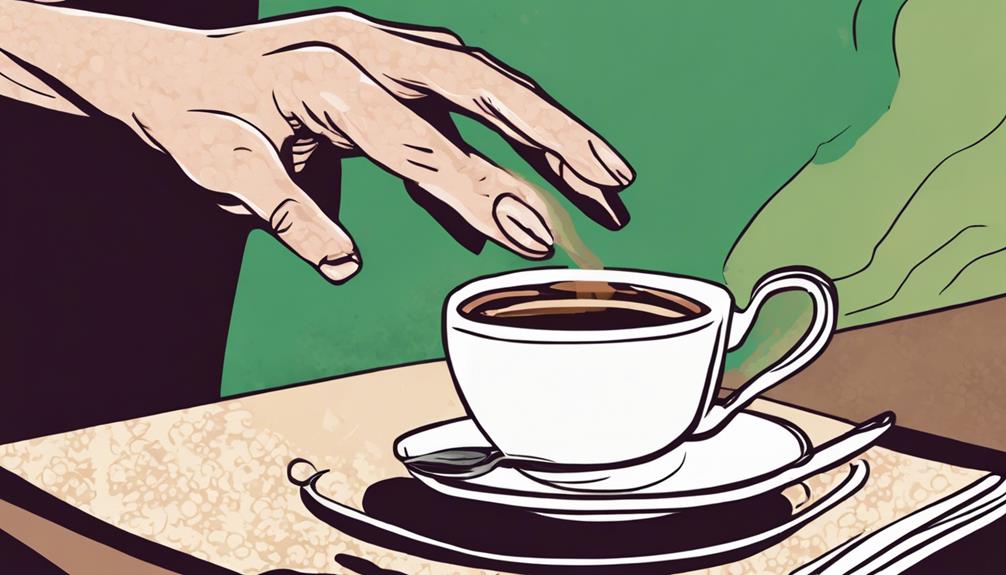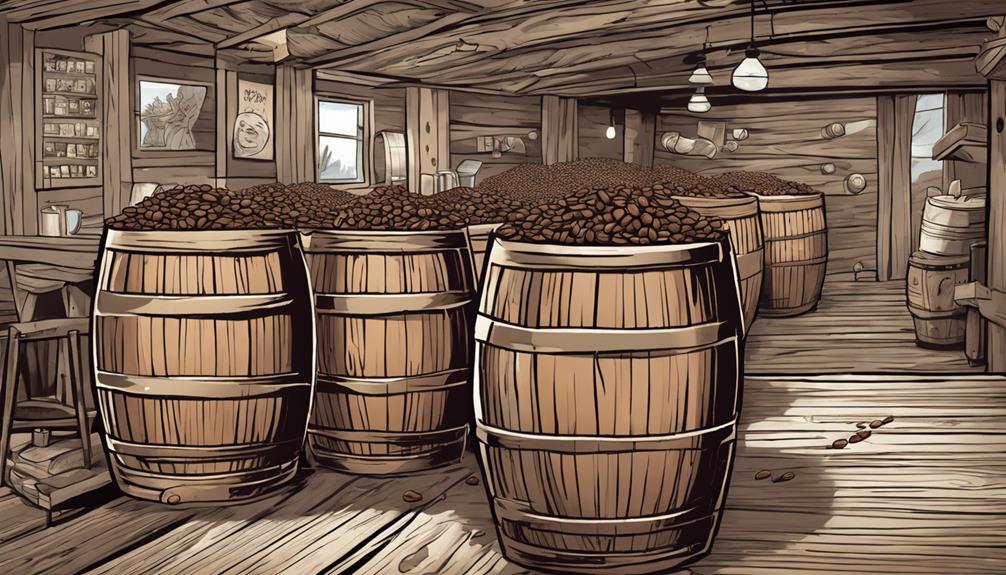Break away from relying on coffee by gradually decreasing your daily intake, tracking your current consumption, and setting a goal to lessen it over time. Switch out caffeinated beverages for decaf alternatives and substitute coffee with herbal teas. Remember to stay hydrated, get enough rest, practice relaxation techniques, exercise regularly, and seek professional help if necessary. By adopting these healthy habits, you can overcome caffeine addiction and relieve physical symptoms of dependence. Embrace a caffeine-free lifestyle that promises improved well-being and energy levels. Keep in mind to also watch your diet, as certain foods and drinks can lead to increased acidity in your body. Try adding alkaline foods like fruits, vegetables, and whole grains to your meals, while limiting acidic foods such as processed meats and alcohol. Practice good oral hygiene and regularly visit the dentist to prevent acidity-related tooth decay and gum disease. By combining these acidity prevention strategies with reducing your caffeine intake, you can achieve a healthier and more balanced lifestyle.
Key Takeaways
- Gradually reduce daily coffee intake.
- Identify current caffeine consumption levels.
- Set a goal to decrease coffee consumption.
- Replace coffee with decaffeinated options.
- Monitor progress and adjust as needed.
Caffeine Addiction Overview
Around 75-80% of people globally regularly consume caffeinated beverages, primarily sourced from coffee, leading to a significant prevalence of caffeine addiction. Over a quarter of caffeine users may meet DSM-5 criteria for substance dependence.
This addiction can manifest through symptoms like irritability, fatigue, and difficulty concentrating when caffeine intake is reduced or stopped abruptly. Known as caffeine withdrawal, these symptoms can be quite uncomfortable, with headaches and mood disturbances being common complaints.
Individuals who consume coffee as part of their daily routine may find themselves relying on it to kickstart their mornings, further solidifying their dependence on caffeine. This dependence can lead to difficulty abstaining from coffee, even when aware of the negative consequences. In addition to dependence on caffeine, individuals may also experience negative physical effects such as increased heart rate and heightened anxiety when they try to cut back on their coffee consumption. Furthermore, the acidity from coffee can lead to digestive issues and discomfort, further complicating the potential negative consequences of dependence on this beverage. It’s important for individuals to be mindful of their coffee consumption and consider seeking support if they find it difficult to reduce or eliminate their intake.
It's important to note that exceeding the recommended daily caffeine limit of 400mg for adults can result in adverse effects such as sleep disruption and headaches, emphasizing the need for moderation in coffee consumption.
Effects on the Body

Let's talk about the impact caffeine can have on your body.
It affects you physically, mentally, and can pose health risks if consumed excessively.
Understanding these effects can help you make informed choices about your caffeine intake.
Physical Effects of Caffeine
Caffeine affects the body by acting as a stimulant to the central nervous system, enhancing energy levels and alertness. Regular consumption of high doses of caffeine can lead to tolerance, necessitating increased intake to achieve the same effects. The primary source of caffeine is coffee, with an average cup containing approximately 95 mg. However, excessive caffeine consumption can disrupt sleep patterns, causing issues like insomnia and restlessness. Consuming large amounts of caffeine may also result in side effects such as headaches, irritability, and elevated heart rate.
| Physical Effects of Caffeine | |
|---|---|
| – Increased energy and alertness | – Insomnia and restlessness |
| – Tolerance with high doses | – Headaches and irritability |
| – Disruption of sleep patterns | – Elevated heart rate |
Cognitive Impact of Caffeine
High doses of caffeine can significantly impact your cognitive functions by serving as a stimulant to the central nervous system, enhancing feelings of alertness and energy.
When ingested, caffeine blocks adenosine receptors in the brain, preventing the onset of drowsiness and promoting wakefulness.
However, regular consumption can lead to tolerance, necessitating higher doses to achieve the same effects over time. Sensitivity to caffeine varies among individuals, with some experiencing jitteriness or a rapid heart rate even at lower doses.
It's crucial to be mindful of your caffeine intake as excessive consumption can disrupt your sleep patterns, leading to fatigue and irritability during the day. Keep in mind that a typical cup of filter coffee contains around 95 mg of caffeine, but this amount can vary based on brewing methods.
Being conscious of how caffeine impacts your cognitive function can help you make informed choices about your daily consumption to avoid dependence and maintain peak mental clarity.
Health Risks of Caffeine
Excessive consumption of caffeine can lead to various health risks and adverse effects on your body. While caffeine is known to boost energy and alertness, exceeding recommended daily limits can result in negative consequences. Here are some effects of caffeine overconsumption:
| Effects of Caffeine | Symptoms of Caffeine | Substance Use Disorder |
|---|---|---|
| Increased heart rate | Insomnia | Tolerance development |
| Digestive issues | Anxiety | Dependence on caffeine |
| High blood pressure | Headaches | Difficulty cutting back |
| Jitters and restlessness | Irritability | Withdrawal symptoms |
To avoid these health risks, it's essential to monitor your daily caffeine intake. Pay attention to your caffeine habit and consider reducing your daily caffeine level if necessary. By staying within the recommended limits and being mindful of your caffeine consumption, you can prevent the development of Substance Use Disorder related to caffeine.
Withdrawal Symptoms

You may experience headaches, fatigue, and irritability when going through caffeine withdrawal. These symptoms usually kick in 12-24 hours after your last caffeine fix.
Understanding how to cope with these withdrawal symptoms effectively is crucial.
Symptoms of Withdrawal
Withdrawal symptoms from caffeine may include headaches, fatigue, and irritability, typically emerging 12-24 hours after your last intake.
If you find yourself experiencing irritability, fatigue, or headaches after cutting down on caffeine, you might be facing withdrawal symptoms. These symptoms can worsen over time, with peak effects occurring around 20-51 hours post-cessation.
Not being able to function properly without your daily caffeine fix is a telltale sign of caffeine dependence. Apart from the more common symptoms like irritability and fatigue, you might also notice a decrease in alertness, increased drowsiness, and difficulty concentrating.
These signs are all indicative of your body reacting to the absence of caffeine, which it has become accustomed to. Understanding these withdrawal symptoms and their timeline can help you navigate the process of reducing your caffeine intake and breaking free from dependence.
Coping With Symptoms
Moving through the challenges of withdrawal symptoms from caffeine cessation involves implementing effective coping strategies to alleviate discomfort and facilitate a smoother change towards reduced intake. When facing withdrawal symptoms like headaches, fatigue, irritability, decreased alertness, and difficulty concentrating, it's crucial to have a plan in place to manage these physical discomforts. Here are some strategies to help you cope:
| Coping Strategy | Description | Benefits |
|---|---|---|
| Stay Hydrated | Drink plenty of water to flush out toxins and stay hydrated, which can help reduce headaches. | Hydration is vital for overall well-being. |
| Get Adequate Rest | Make sure you get enough sleep to combat fatigue and improve overall mood and alertness. | Rest is essential for the body to recover. |
| Practice Relaxation Techniques | Engage in activities like deep breathing, meditation, or yoga to reduce stress and irritability. | Relaxation can help soothe the mind and body. |
| Exercise Regularly | Physical activity can boost mood, energy levels, and focus, helping counteract withdrawal symptoms. | Exercise promotes overall health and wellness. |
| Consider Professional Help | If withdrawal symptoms severely impact your daily functioning, seeking professional assistance may be necessary. | Professional guidance can offer tailored support. |
Reduce Caffeine Dependence

To reduce caffeine dependence, gradually decrease your daily intake of caffeinated beverages. Start by identifying your current caffeine consumption and setting a goal to reduce it over time. Cutting down too quickly can lead to withdrawal symptoms like headaches and fatigue.
Instead, taper off your caffeine use by replacing some caffeinated drinks with decaffeinated options or herbal teas. This method can help your body adjust more smoothly.
Reducing your caffeine intake can help alleviate physical symptoms associated with caffeine dependence, such as restlessness and increased heart rate. By gradually decreasing your consumption, you may also notice improvements in your sleep quality and mood.
Remember that dependence on caffeine can have negative impacts on your overall well-being. Seeking treatment options, such as counseling or support groups, can provide strategies to address your caffeine dependence and any underlying issues it may be masking.
Prioritize your health by taking steps to reduce your reliance on caffeine.
Signs of Dependence
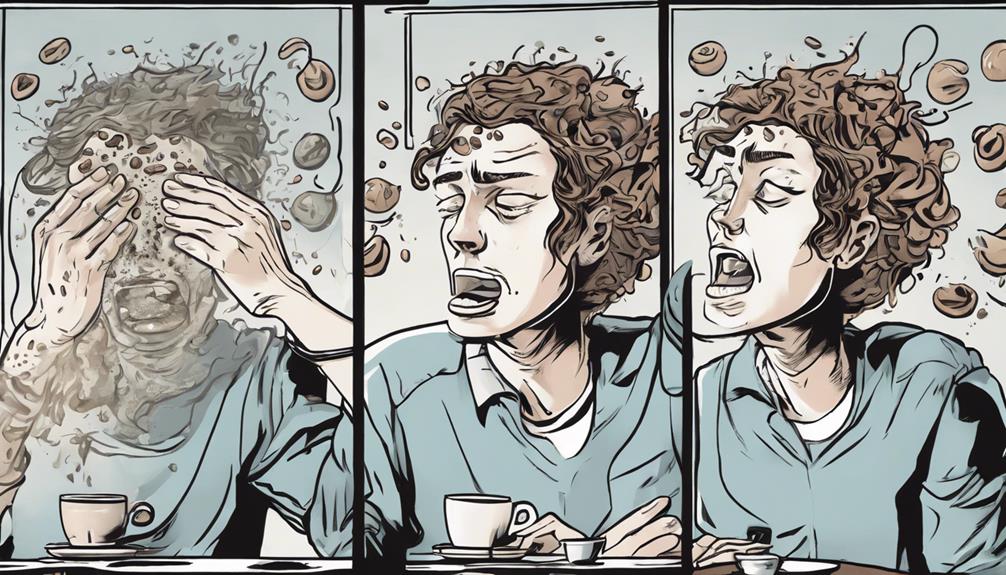
You need to be aware of the signs that indicate caffeine dependence.
If you find yourself struggling to function without your daily dose of coffee, it may be a red flag.
Pay attention to how caffeine affects your daily life and well-being to determine if you might be dependent.
Recognizing Dependence Signs
Recognizing signs of dependence on caffeine involves paying attention to how much distress you feel when not consuming it. Here are some key signs to look out for:
- Disruption in daily life: If your caffeine consumption starts interfering with your daily activities, such as work, relationships, or responsibilities, it may indicate dependence.
- Excessive consumption: Consuming more than the recommended daily caffeine limit of 400mg for adults can lead to negative effects like sleep disturbances, headaches, and irritability.
- Potential substance use disorder: Dependence on caffeine may be a sign of a substance use disorder. If you find yourself relying heavily on caffeine to function or experiencing withdrawal symptoms when you don't consume it, it could be indicative of an underlying issue that needs addressing.
Being aware of these signs can help you evaluate your relationship with caffeine and take steps towards a healthier balance in your consumption.
Impact on Daily Life
Relying on caffeine can significantly disrupt your daily routines and functioning, impacting various aspects of your life. When you find yourself feeling distressed or unable to function without your regular dose of caffeine, it could be a sign of dependency.
Surpassing the recommended daily limit of 400mg for adults may indicate that you have developed a reliance on caffeine. The side effects of consuming excessive amounts of caffeine, such as sleep disruption and irritability, can have a significant impact on your daily activities.
If your caffeine consumption starts to interfere with your daily routines or causes distress when you're unable to have it, these could be clear indicators of dependency. It's crucial to be aware of how your caffeine intake is affecting your daily life to prevent it from becoming a hindrance rather than a boost to your productivity and overall well-being.
Overcoming Dependence

How can you effectively overcome your caffeine dependence and reduce your intake of coffee and other caffeinated beverages? Overcoming dependency on caffeine can be challenging, but with the right strategies, you can successfully lower your consumption and manage withdrawal symptoms.
Here are some tips to help you in this process:
- Gradually reduce your caffeine intake: Instead of quitting cold turkey, slowly decrease the amount of caffeine you consume each day. This can help minimize the intensity of withdrawal symptoms.
- Switch to decaffeinated alternatives: Replace some of your regular caffeinated drinks with decaffeinated options. This can help lower your overall caffeine consumption while still enjoying a similar beverage.
- Recognize the impact on cognitive performance: Understanding how caffeine affects your cognitive function can be a strong motivator to cut back. Improved focus and mental clarity can be achieved by reducing dependency on caffeine.
Consequences of Dependence
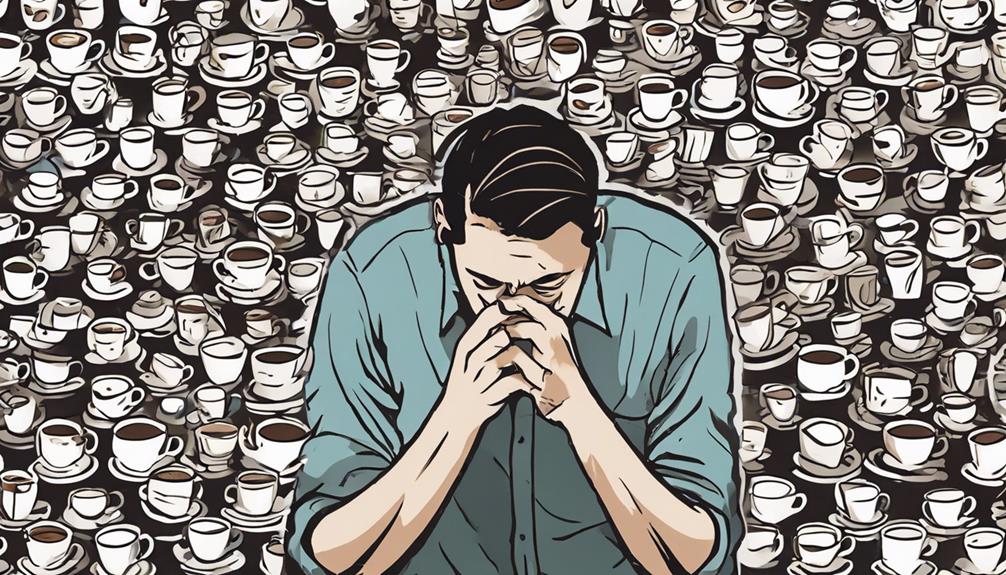
Experiencing sleep disruption, headaches, and irritability are common consequences of excessive caffeine use. When relying heavily on caffeine, you may be masking underlying mental health issues such as anxiety or depression.
Caffeine dependence can sometimes be a sign of a broader substance use disorder, indicating a need for professional help. Using caffeine as a coping mechanism may also suggest deeper emotional or psychological struggles that require attention.
Withdrawal symptoms from caffeine dependence can be challenging, including headaches, fatigue, irritability, and difficulty concentrating. These symptoms can disrupt daily functioning and may lead to a cycle of increased caffeine consumption to alleviate them, perpetuating the dependence.
It's essential to recognize the potential consequences of excessive caffeine use and address any underlying issues contributing to this dependency. Seeking professional help can provide support in managing caffeine intake and uncovering and addressing any mental health concerns that may be intertwined with caffeine dependence.
Professional Perspectives
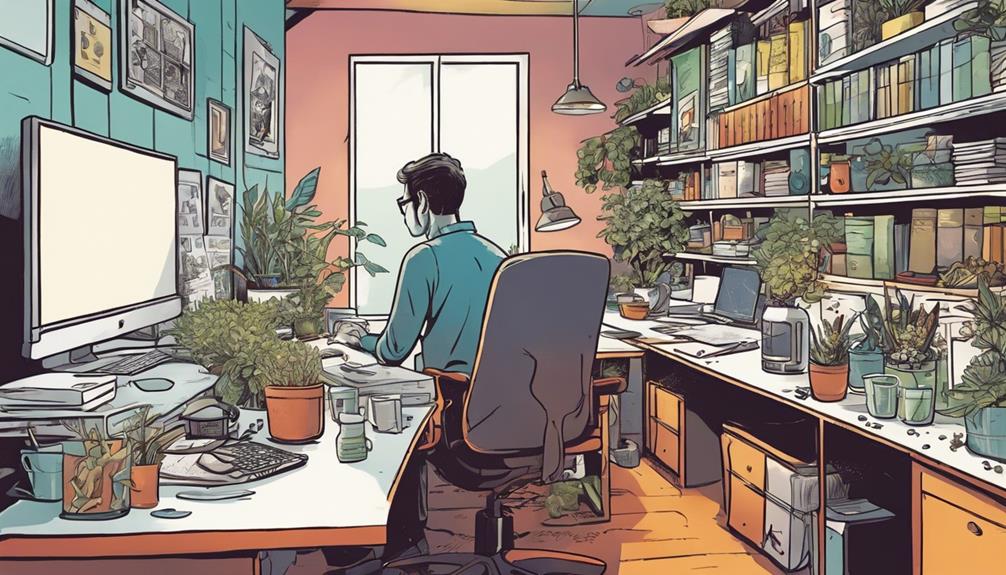
When pondering caffeine consumption, understanding the viewpoints of healthcare professionals can illuminate the complexities of tolerance and dependence associated with regular intake. Health care professionals acknowledge that while caffeine isn't addictive like drugs or alcohol, tolerance and dependence are common among habitual consumers.
Withdrawal symptoms can emerge when abruptly ceasing caffeine intake, highlighting the physiological impact of regular consumption. Additionally, excessive intake of caffeine can lead to physical side effects that may harm overall well-being.
Seeking professional help is essential in addressing underlying issues related to caffeine dependence, offering strategies for long-term solutions. Here are some key points to keep in mind from professional perspectives:
- Caffeine Dependence: Acknowledged as a prevalent issue among regular consumers.
- Physical Side Effects: Can manifest with excessive caffeine consumption, impacting health.
- Professional Help: Vital in addressing caffeine dependence for sustainable long-term solutions.
Must-Reads on Caffeine

Exploring important readings on caffeine can provide valuable insights into its effects and management strategies. Consuming caffeine every day can lead to physical dependence, with symptoms of withdrawal like headaches and irritability if you suddenly stop.
It's vital to be mindful of the amount of caffeine you intake, as excessive consumption can result in side effects such as increased blood pressure and heart palpitations. Pregnant women are advised to limit their caffeine intake to avoid potential risks to the developing fetus.
To manage caffeine dependence, gradually reduce your intake, consider switching to decaf or non-caffeinated beverages, and explore herbal supplements like ginseng.
Remember that moderate amounts of caffeine are generally safe, but it's important to be aware of your consumption levels. If you're struggling to cut back on caffeine, consulting your healthcare provider for guidance can be beneficial in creating a suitable plan for you.
Quitting Without Headache

Gradually reducing your caffeine intake can help alleviate withdrawal symptoms like headaches and irritability when quitting without headache. Tapering off caffeine slowly is key to avoiding the discomfort associated with sudden withdrawal.
Here are three vital tips to help you quit caffeine without the headache:
- Avoid Cold Turkey: Abruptly stopping caffeine consumption can worsen your caffeine dependence and lead to more severe withdrawal symptoms, including headaches.
- Consider Prescription Medications: If you're taking prescription medications that contain caffeine, reducing your overall caffeine intake may be essential in breaking the cycle of dependency and avoiding withdrawal headaches.
- Explore Alternative Pain Relief: Using caffeine-containing painkillers for headaches can perpetuate your caffeine dependence. Instead, opt for alternative pain relief methods to manage headaches without exacerbating your reliance on caffeine.
Frequently Asked Questions
How Do You Cure Caffeine Dependence?
To cure caffeine dependence, gradually cut back on intake, switch to decaf, and stay hydrated. Create a plan to reduce consumption and seek help if needed. Breaking the cycle is key. Stay committed and make positive changes.
How Can I Rely Less on Coffee?
Struggling to cut back on coffee? Start by gradually reducing your intake, trying half-caff or decaf, and swapping for herbal teas. Develop a morning routine without coffee, stay hydrated, and prioritize sleep for sustained energy.
How Can We Prevent Coffee Consumption?
To prevent coffee consumption, start by limiting your intake to recommended levels. Gradually switch to decaf or caffeine-free options. Avoid coffee before bedtime for better sleep. Stay hydrated to reduce the urge for coffee. Watch out for hidden caffeine sources in foods.
Why Am I so Dependent on Coffee?
Feeling dependent on coffee may stem from routine reliance, associating it with energy. Excessive consumption can lead to tolerance, making you need more for the same effect. Break the cycle by diversifying your energy sources. Explore alternative ways to boost your energy, such as exercising regularly, eating a balanced diet, and getting enough sleep. Additionally, consider reducing your coffee intake gradually to avoid withdrawal symptoms. If you’re concerned about the acidity of coffee, consider switching to cold brew or adding milk or a coffee creamer to lower the acidity. Look into different brewing methods and types of coffee beans to see how to avoid coffee acidity.
Conclusion
So, next time you reach for that third cup of coffee, remember that breaking free from caffeine dependence is like taking off a heavy backpack after a long hike.
It may be challenging at first, but your body will thank you in the long run. Embrace healthier habits, listen to your body, and enjoy the natural energy that comes from taking care of yourself.
You've got this!


